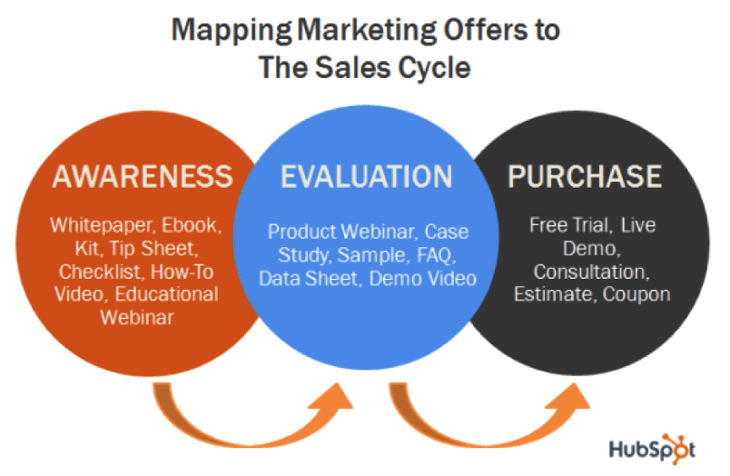3 Effective Content Marketing Strategies for Startups

Content is king.
Mainly because content translates information into stories. And who doesn't like stories?
Also, looking at content in terms of its marketing value, it is safe to say that content marketing brings great results in minimum budget. Content marketing costs 62% less than outbound and yet generates 3x more leads.
This makes it a very appealing strategy for startups to begin with.
But content, like any other strategy, produces effective results only when best practices are followed.
Here is a look at 3 such effective content marketing strategies that work really well for startups:
1. Create an outline of buyer's journey and plan your content for the different stages
While every marketing funnel goes through 1) awareness, 2) consideration/evaluation and 3)purchase stage; these stages are just broad classifications. The actual consumer journey can be longer or shorter depending on the sales funnel.
Additionally, the content type which works at one stage may not be as effective for other stages.
A great way to engage your audience effectively at different touchpoints is to offer them the most useful content for that stage. + Content for attracting potential leads (short form content)
Examples: Explainer videos, E-books
+ Content for easing the evaluation (detailed analysis)
Examples: Webinars, Case studies
+ Content to influence purchase decision (persuasive approach)
Examples: Testimonials, Email

Plotting your customer's roadmap helps you in putting on your audience's shoes and look at the purchase journey from their point of view. This helps you in crafting content which works well for them as well as for you. Useful content creates a win-win space.
Key Takeaway: As the user moves ahead on his buying journey, persuasion takes different approaches and hence it is vital to use different content types to get the best out of that particular stage. For instance, crisp and engaging video ads introduce your audience to your product, helping them understand how it fits in their life. And then webinars can help them in evaluating you against other brands.
2. Focus on creating evergreen content
Writing evergreen content is crucial. Because such content appeals to new as well as existing customers. And evergreen content plays a major role in repeat visits to your website.

Additionally, evergreen content is not bound by time. It continues to bring in results long after it is published.
At its core, evergreen content is customer-focused. Also, it is timeless because it explains a frequently occurring problem and offers the solution at the same time.
That's not to say that viral content doesn't offer any value. Viral content can be a great way to create a buzz and find visibility. And these two things are great for any startup. But "virality" shouldn't be the focus of your content strategy.
Additionally, viral content is rarely built with a "customer-centric" intent. So if your content strategy relies only on virality, your consumers will sense it and eventually might stop engaging with your content.
The key is to create content that solves the problems faced by your readers.
Key Takeaway: Creating buzz through viral content may look very appealing, especially to those who are starting out, but using it as a core value disengages your readers over a period of time. When building your content plan, make sure that you focus on offering solutions to your readers.
3. Tap into the power of visual content to boost engagement
The effectiveness of visual content isn't limited to your website. Visuals are, in fact, necessary for engagement on social platforms.
Any good content marketing strategy is incomplete without visuals.
Visuals are processed faster, they help in better retention and they are much more effective in engaging the viewers than text-only content.

Visuals condense a lot of information which would otherwise require multiple lines of text.
Additionally, incorporating visuals in your content strategy isn't a challenge. If GIFs don't work for your brand image, you can rely on infographics or even videos. The variety of available content options ensure that you don't struggle to include them in your posts.
Also, here are a few quick stats which show the significance of visuals on social platforms:
- Tweets with images receive 150% more retweets than tweets without images.
- Facebook users watch 8 billion videos per day.
Key Takeaway: Incorporating visuals boosts your website conversions and also creates better social interactions. Plus visuals ease the information dissipation process. With infographics, you can translate complex data into simpler information. Similarly, you can use videos for How-to tutorials, visual demonstrations which help in building trust.
Quick Recap
- Ensure that you reach out to your customers with different content styles at different points. This helps in eliminating the monotony and creates effective engagement.
- Evergreen content brings evergreen results. So focus on writing posts which are not time critical.
- Your content can create effective touchpoints in the consumer journey as long as you use the right content formats for the right situations.
- Visuals have a strong engagement value. At a time when viewers' attention span is down to 8 seconds, your content strategy cannot work without visuals.








